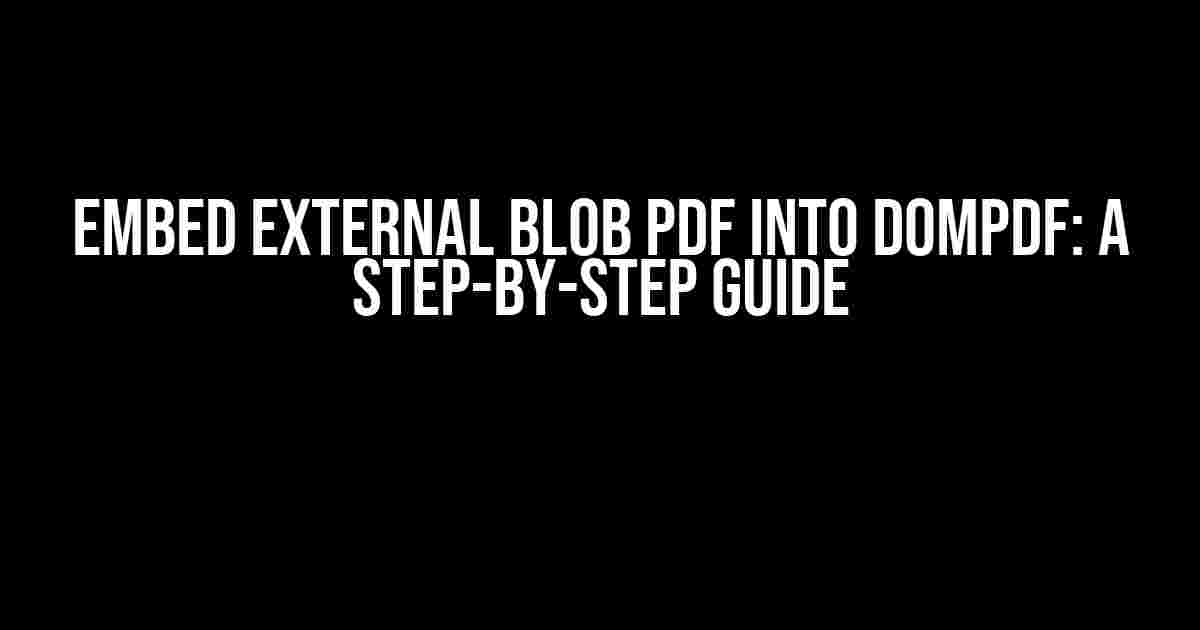Introduction
In today’s digital age, generating PDFs on the fly is a common requirement for many web applications. DomPDF is a popular PHP library that helps you create PDFs from HTML content. However, what if you need to embed an external PDF into your generated PDF using DomPDF? Don’t worry, we’ve got you covered! In this article, we’ll show you how to embed an external blob PDF into DomPDF, making your PDF generation process more efficient and flexible.
What is DomPDF?
Before we dive into the tutorial, let’s briefly introduce DomPDF. DomPDF is a PHP library that allows you to generate PDFs from HTML content. It’s a popular choice among developers due to its ease of use, flexibility, and high-quality output. With DomPDF, you can create complex PDF documents, including tables, images, and external links.
Prerequisites
To follow this tutorial, you’ll need:
- A PHP-enabled web server (e.g., Apache, Nginx, or IIS)
- DomPDF library installed (download the latest version from the official website)
- A basic understanding of PHP and HTML
- An external PDF blob (we’ll use a sample PDF file for demonstration)
Step 1: Prepare Your External PDF Blob
For this tutorial, we’ll assume you have an external PDF blob stored on your server or a remote location. You can use any PDF file for demonstration purposes.
Here’s a sample PDF file: sample.pdf
Step 2: Set Up DomPDF
Create a new PHP file (e.g., `embed_pdf.php`) and include the DomPDF library:
<?php
require_once 'dompdf/autoload.inc.php';
use Dompdf\Dompdf;
?>Step 3: Create a New DomPDF Instance
Create a new instance of the DomPDF class:
$dompdf = new Dompdf();Step 4: Load the External PDF Blob
Load the external PDF blob using the `file_get_contents()` function:
$pdf_blob = file_get_contents('https://example.com/sample.pdf');Step 5: Create a New HTML Document
Create a new HTML document that will contain the embedded PDF:
<html>
<body>
<h1>Embedded PDF</h1>
<object data="data:application/pdf;base64,<?php echo base64_encode($pdf_blob); ?>" type="application/pdf" width="100%" height="500">
< embed src="data:application/pdf;base64,<?php echo base64_encode($pdf_blob); ?>" type="application/pdf" width="100%" height="500">
</object>
</body>
</html>Step 6: Generate the PDF
Load the HTML document into DomPDF and generate the PDF:
$dompdf->loadHtml($html);
$dompdf->render();
$pdf = $dompdf->output();Step 7: Save the Generated PDF
Save the generated PDF to a file or send it as a response:
file_put_contents('output.pdf', $pdf);
// or
header('Content-Type: application/pdf');
header('Content-Disposition: attachment; filename="output.pdf"');
echo $pdf;Troubleshooting Tips
If you encounter issues with the PDF generation process, check the following:
- Make sure the external PDF blob is accessible and not corrupted.
- Verify that the DomPDF library is installed and configured correctly.
- Check the PHP error logs for any errors or warnings.
Conclusion
Embedding an external blob PDF into DomPDF is a straightforward process once you know the correct approach. By following this step-by-step guide, you should now be able to generate PDFs with embedded external PDFs using DomPDF. Remember to adjust the code to fit your specific requirements and handle any potential issues that may arise.
Bonus: Advanced Usage
For advanced users, you can further customize the embedding process by:
- Using JavaScript to dynamically load the PDF blob
- Applying CSS styles to the embedded PDF
- Adding security restrictions to the generated PDF
| Property | Description |
|---|---|
| data | The base64-encoded PDF blob |
| type | The MIME type of the PDF (application/pdf) |
| width | The width of the embedded PDF (in pixels) |
| height | The height of the embedded PDF (in pixels) |
Remember to explore the official DomPDF documentation for more advanced features and customization options.
Final Thoughts
In this article, we’ve demonstrated how to embed an external blob PDF into DomPDF, enabling you to generate complex PDF documents with ease. With this knowledge, you can take your PDF generation skills to the next level and create more dynamic and engaging documents for your users. Happy coding!
Frequently Asked Question
Get answers to the most common questions about embedding external blob PDF into DomPDF.
What is the difference between embedding a PDF as a blob versus as a file?
When you embed a PDF as a blob, you’re essentially storing the PDF data as a binary large object in your database. This approach allows for more flexibility in terms of PDF manipulation and storage. On the other hand, embedding a PDF as a file involves storing the PDF as a physical file on your server or file system. While both methods have their advantages, embedding as a blob provides more control and scalability.
How do I generate a PDF blob from an existing PDF file?
You can generate a PDF blob from an existing PDF file by reading the file using a file reader or a library like `file_get_contents()` in PHP. Then, use the `base64_encode()` function to convert the file content into a base64-encoded string. This string can be stored as a blob in your database. When you need to use the PDF, simply decode the blob using `base64_decode()` and output it as a PDF.
Can I embed an external PDF blob into DomPDF using PHP?
Yes, you can embed an external PDF blob into DomPDF using PHP. First, retrieve the PDF blob from your database or storage. Then, use the ` DomPDF` library to create a new PDF instance. Next, use the `add_page()` method to add a new page to the PDF, and then `embed()` method to embed the external PDF blob into the new page. Finally, output the generated PDF using the `output()` method.
What are some common issues I might encounter when embedding an external PDF blob into DomPDF?
When embedding an external PDF blob into DomPDF, you might encounter issues like PDF corruption, invalid PDF structure, or encoding problems. To troubleshoot these issues, check the PDF blob for corruption, ensure the correct PDF encoding, and verify that the PDF is correctly embedded into the DomPDF instance. You can also try debugging the PDF generation process to identify the root cause of the issue.
Are there any performance considerations when embedding external PDF blobs into DomPDF?
Yes, there are performance considerations when embedding external PDF blobs into DomPDF. Since PDF blobs can be large, they can consume significant memory and processing power. To optimize performance, consider using lazy loading, caching, or streaming the PDF blob instead of storing it in memory. Additionally, optimize your PDF generation process to minimize the number of PDF operations and reduce the overall PDF size.





